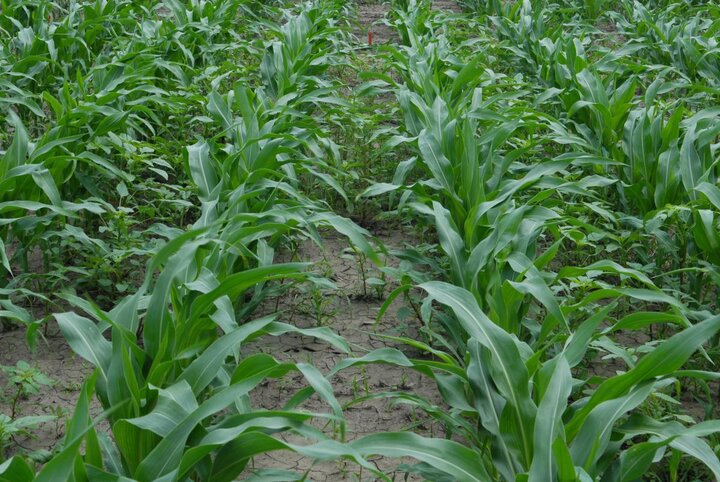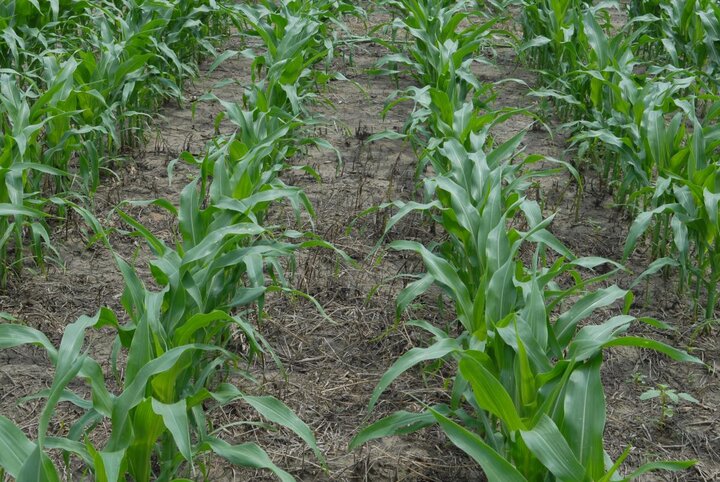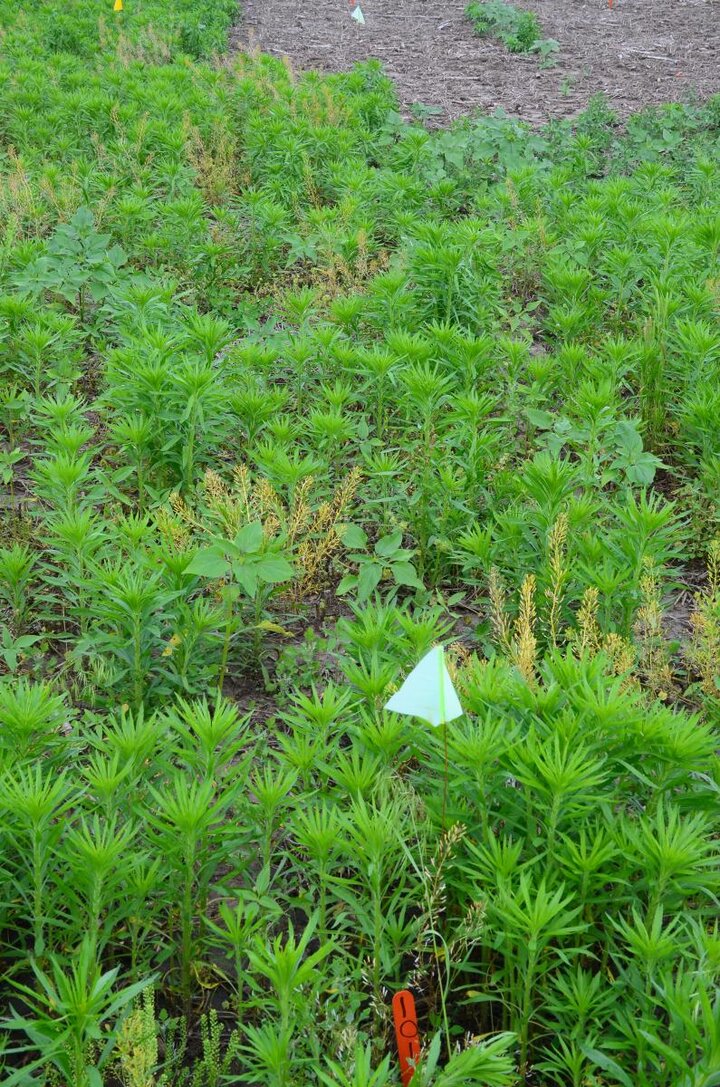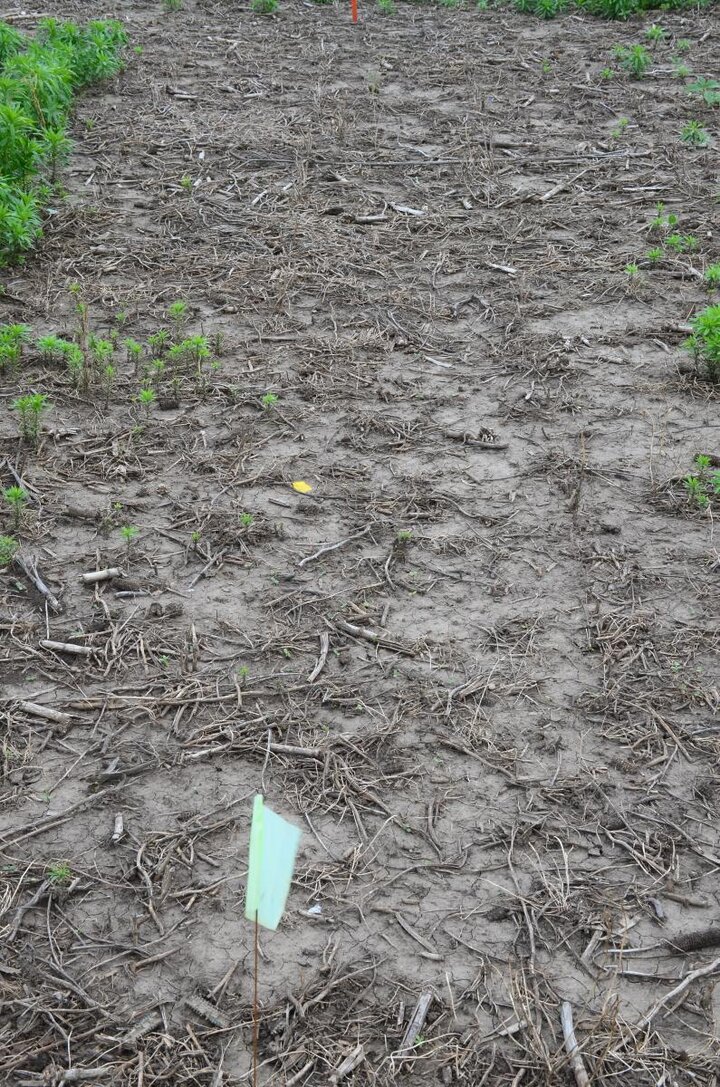

Acuron™ is a combination of four herbicide active ingredients: atrazine (10.93%), bicyclopyrone (0.65%), mesotrione (2.6%), and S-metolachlor (23.4%) plus the safener benoxacor. Acruron may be used pre-emergence and post-emergence in field corn, seed corn, and silage corn. Acuron may also be used in sweet corn and yellow popcorn, but the application must be made prior to crop emergence (i.e., pre-emergence), or serious crop injury may occur.
When tank mixing or sequentially applying atrazine or products containing atrazine with Acuron to corn, do not exceed an application rate of 2.0 lb active ingredient of atrazine per acre for any single application. Total atrazine applied must not exceed 2.5 lb active ingredient per acre per year.
Research conducted at UNL’s South Central Ag Research Lab near Clay Center reported excellent control of several hard-to-control weeds such as common waterhemp, Palmer amaranth, velvetleaf, common lambsquarters, and foxtail species with Acuron applied pre-emergence in corn at 2.5 qt/acre (Figure 1 A and B). Research conducted at UNL’s Havelock Farm in Lincoln reported more than 90% control of glyphosate-resistant marestail in a bare ground study (Figure 2 A and B).


Soil Organic Matter
The organic matter content of the soil on which it will be applied needs to be known or determined prior to applying Acuron. The use rate of Acuron is based on percent soil organic matter. On soils with greater than 10% organic matter, Acuron activity may be affected, resulting in reduced or poor weed control.
Reduced and No-Till Systems
Acuron may be used in reduced and no-till systems. The highest levels of control will be obtained when applications are made as close to planting as possible. It is recommended that a burndown herbicide such as Gramoxone, Touchdown brands, Roundup brands, or 2,4-D be tank-mixed with Acuron in reduced or no-till systems if weeds are present at time of application and the corn has not yet emerged.
Rotational Crops
When Acuron is applied as directed on this label, follow the crop rotation intervals in Table 2. If Acuron is tank-mixed with other products, follow the most restrictive product’s crop rotation interval. Do not rotate to food or feed crops other than those listed on this label.
| Soil Organic Matter Content | Application RateA |
|---|---|
| 2.5 qt/ac | |
| ≥ 3% | 3.0 qt/ac |
| ADo not exceed 3.0 qt/ac of Acuron rate per year. | |
| Crop | Replant/Rotation Interval |
|---|---|
|
Field corn |
Anytime(1) |
| Small grain cereals including wheat, barley, and rye | 4 months |
| Dry beans (2) Potato Soybeans (3,4) Sorghum (all types) |
10 months(5,6) |
| All other rotational crops | 18 months |
|
(1) Do not re-apply Acuron. |
|
Adjuvants
It’s recommended that adjuvants used with this herbicide meet the standards of the Chemical Producers and Distributors Association (CPDA) adjuvant certification program. Where Acuron is applied after the corn has emerged, a non-ionic surfactant (NIS) at 0.25% v/v (1 gal/100 gal) or not more than the equivalent of 1 qt/ac may be used. Do not use nitrogen-based adjuvants (AMS or UAN) or methylated seed oil (MSO) with Acuron when applied alone to emerged corn, or when Acuron is applied as a post-emergence tank mixture with other products, unless directed for a specific tank mix on this label as part of a supplemental Acuron label. Any of these adjuvants may be used at a pre-emergence or preplant timing, i.e., where the corn crop has not yet emerged to increase burndown activity on existing weeds. Do not apply Acuron to emerged sweet corn or yellow popcorn or severe injury may occur.
Sprinkler Irrigation
Do not apply Acuron by sprinkler irrigation. After Acuron has been applied, a sprinkler irrigation system set to deliver ½-1 inch of water may be used for incorporation. Using more than 1 inch of water could result in reduced performance. On sandy soil loam in organic matter, use no more than ½ inch of water. Do not use flood irrigation to apply or incorporate Acuron.
Information on Droplet Size
The most effective way to reduce spray drift potential is to apply large droplets. Use only nozzles producing medium to ultra coarse droplets. Do not use nozzles producing fine droplets.
Controlling Droplet Size
- Volume: Use high flow rate nozzles to apply the highest practical spray volume. Nozzles with higher rated flows produce larger droplets.
- Pressure: Do not exceed the nozzle manufacturer’s recommended pressures. For many nozzles types, lower pressure produces larger droplets. When higher flow rates are needed, use higher rate nozzles instead of increasing pressure.
- Number of Nozzles: Use the minimum number of nozzles that provide uniform coverage.
Crop Use Directions
Acuron is to be used for pre-emergence use for control of most annual grass and broadleaf weeds in field corn, seed corn, silage corn, sweet corn, and yellow popcorn. Acuron may also be applied early post-emergence for the control of broadleaf weeds in field corn, seed corn, and silage corn. Do not apply Acuron to emerged sweet corn or yellow popcorn or severe crop injury will occur.
Acuron Programs with Glyphosate in Glyphosate-Tolerant Corn
Acuron may be applied early post-emergence at a rate of 1.5 to 2 qt/ac in tank mixture with a glyphosate product (e.g., Touchstone, Roundup, etc.) that is registered for use over-the-top in glyphosate-tolerant field corn (e.g., Roundup Ready or Agrisure GT Corn). To minimize weed competition with the crop, target the application of this mixture to weeds in the 1- to 2-inch range. Do not apply this mixture to corn that is more than 12 inches tall. If the glyphosate product has a built-in adjuvant system (i.e., the product label does not ask for additional adjuvant), only spray-grade ammonium-sulfate (AMS) at 8.5 lb/100 gal should be added to this mixture. If the glyphosate product label calls for an adjuvant in addition to AMS, add a non-ionic surfactant (NIS) at 0.25% v/v and AMS to this spray mixture. Do not add urea ammonium nitrate (UAN), crop oil concentrate (COC), or methylated seed oil (MSO) type adjuvants to these mixtures, or crop injury may occur. Follow all directions for use and restrictions on the glyphosate product label.
Acuron may be applied post-emergence at 1.25 to1.5 qt/ac as part of a two-pass weed control system when followed by Halex GT post-emergence in glyphosate-tolerant corn (e.g., Roundup Ready or Agrisure GT Corn). Follow all directions for use and restrictions on each product label.
Acuron Use Restrictions
- Grazing Restriction: To avoid possible illegal residues, do not graze or feed forage from treated areas for 45 days after application.
- Pre-Harvest Interval (PHI): Corn (for grain, seed, or silage) may be treated up to 12 inches tall. Do not harvest forage within 60 days after application.
- Do not apply more than 3.0 qt. of Acuron per acre per growing year.
- Do not use aerial application for Acuron.
- Do not apply Acuron to sweet corn or yellow popcorn after the crop has emerged or severe crop injury may occur.
- Do not use Acuron on any crop other than corn (for grain, seed, or silage), sweet corn (pre-emergence applications only) or yellow popcorn (pre-emergence applications only).
- Do not use Acuron in white popcorn or ornamental (Indian) corn or injury may occur.
- Do not contaminate irrigation water used for crops or water used for domestic purposes.
- Thoroughly clean sprayer or other application device before using. Dispose of cleaning solution in a responsible manner. Do not use a sprayer or applicator contaminated with other materials, or crop damage or sprayer clogging of the application device may occur.
